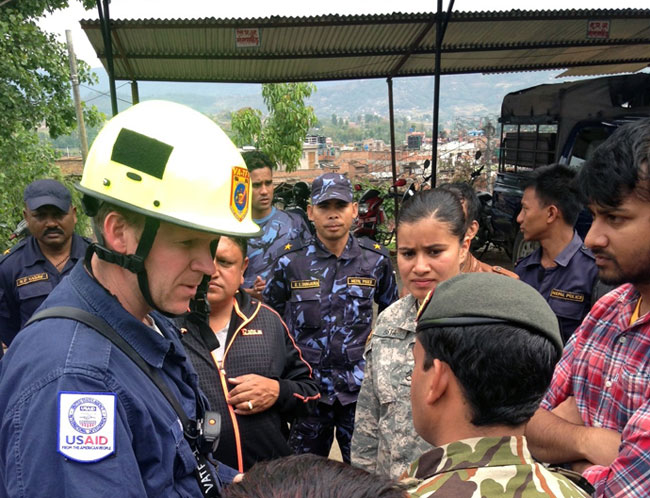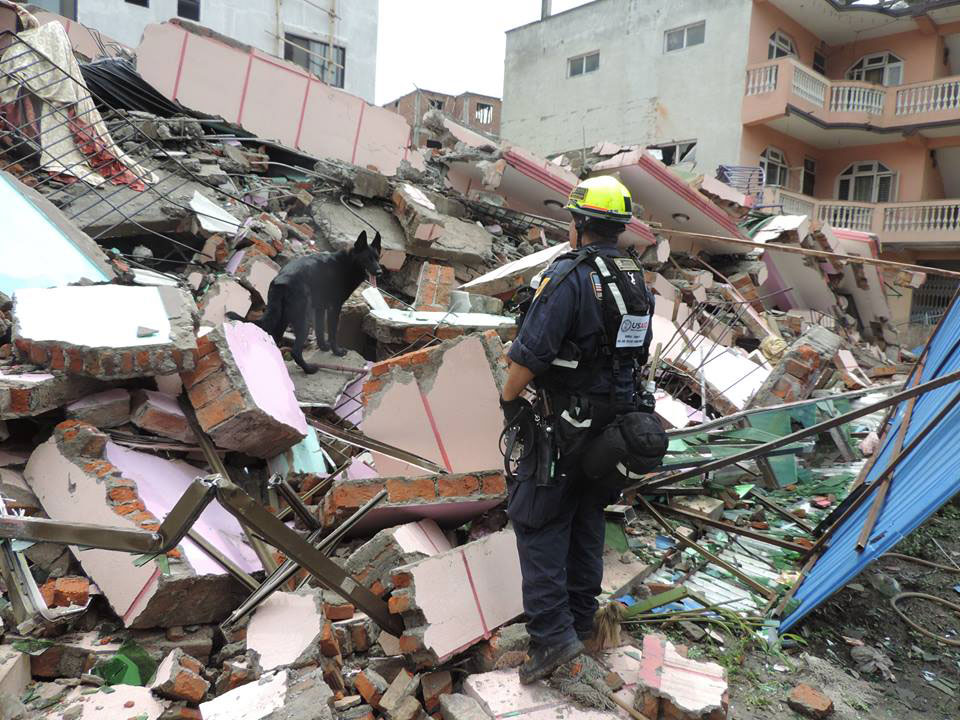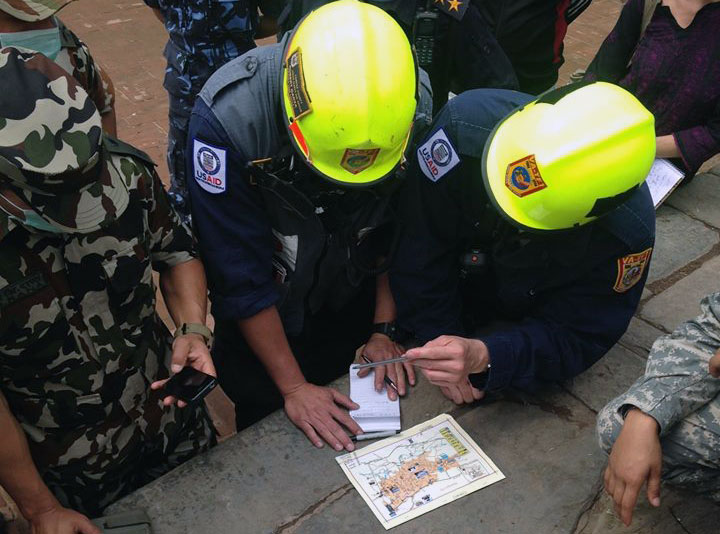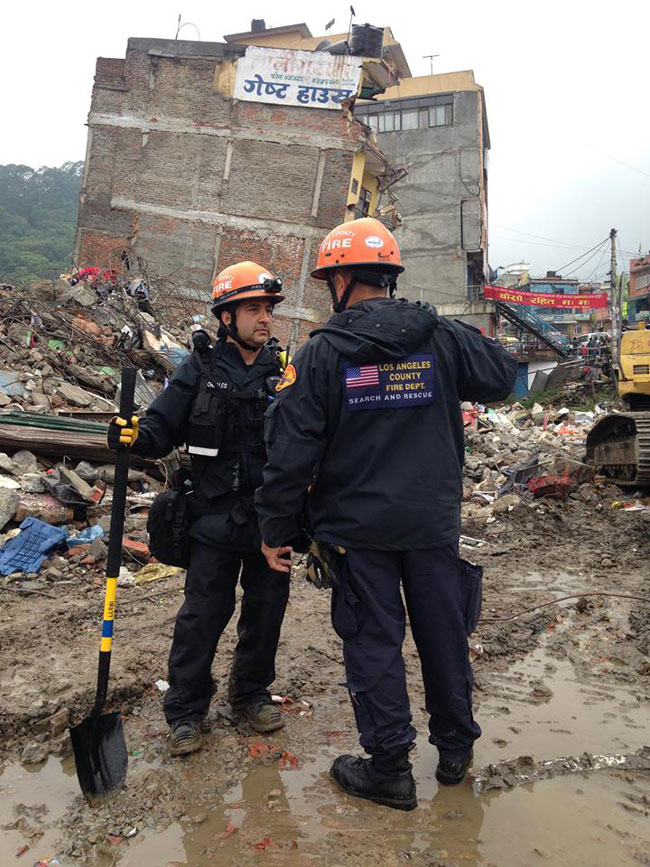FEATURE: Search-and-rescue worker looks back on ‘intense,’ rewarding deployment in quake-hit Nepal
As international search-and-rescue teams start wrapping up their activities in Nepal following the Government’s decision to call off ground operations there, Dewey Perks, a rescue worker soon heading back to the United States, describes his time in the small South Asian nation trying to save lives as both “very intense” and highly rewarding.
Speaking to the UN News Centre about his deployment in the capital, Kathmandu, after Nepal was struck by a devastating 7.8-magnitude earthquake on 25 April, he recalled the rescue of a Nepalese teenager.
On that particular day, after four tense hours, Mr. Perks’ team and the Nepalese police were able to rescue a 15-year-old boy, who had been stuck inside a hole.
“We had two units in the field coming to a cross-point in the sector they’d been assigned to, and they observed that heavy equipment was being used [by Nepalese police] to take a building apart,” Mr. Perks said by phone.
This process, he explained, is typically used to clear a site and recover the bodies of the deceased.
“Suddenly, their dogs were alerted by human scent,” he said. Mr. Perks’ team then worked in cooperation with the local police force, helping them go deeper into the building.
“It was a very intense situation,” he said. “They had to make sure not to cause the entire building to collapse.”
Ultimately, the rescue operation was a success, and the boy was able to get immediate medical assistance.
“It was really a good example of cooperation, in line with international spirit, where the local authorities were in charge and we were able to provide them with tools to go into the building,” he said.

Urban-search-and-rescue members of USAID's Disaster Assistance Response Team (DART) at work in Nepal. Photo: USAID's Disaster Assistance Response Team
Mr. Perks is a seasoned member of the Office of US Foreign Disaster Assistance at the US Agency for International Development (USAID) whose personal involvement in urban search-and-rescue operations dates back to the early 1990s. One of his primary responsibilities at USAID is to coordinate the US search-and-rescue teams deployed in the aftermath of disasters.
Though Mr. Perks works for the US Government, he considers himself part of a broader international effort coordinated by the International Search and Rescue Advisory Group (INSARAG), a network of over 90 disaster-prone and disaster-responding countries and organizations under the umbrella of the UN Office for the Coordination of Humanitarian Affairs (OCHA) that is dedicated to urban search-and-rescue since 1991.
Because of the high likelihood of an earthquake in Nepal, INSARAG has had a longstanding interest in the country prior to the recent catastrophe.
“In case of a major earthquake, we knew that it would be a great challenge to get there and that it would also be a great challenge to operate once we arrived,” said Mr. Perks.

Urban-search-and-rescue members of USAID's Disaster Assistance Response Team (DART) at work in Nepal. Photo: USAID's Disaster Assistance Response Team
When asked about the circumstances surrounding his deployment in Kathmandu, Mr. Perks pointed out the difficulties in access faced by his team and others.
“We stayed most of the day [25 April], like everyone else, looking for airplanes to get there. We knew there was a very tiny airport [in Kathmandu] and that it was closed early on,” he said.
Ultimately, he explained, his agency used a US military aircraft, which required far less space for take off and landing than civilian ones, to fly to the Nepalese capital on Tuesday morning, three days after the earthquake.
“While the plane was being unloaded, we went through the normal border crossing procedures and sent a small party to the [INSARAG] Reception-Departure Centre to find out where the other teams were, get a situation update, as well as to receive an assignment for where we should start operations,” he continued.
Eventually, he and his team moved to an area of Kathmandu recommended by the US Embassy, where they established their base of operations, using information from the Reception-Departure Centre and the UN Disaster Assessment and Coordination (UNDAC) team, which was already on the ground, to assess the area.

Urban-search-and-rescue members of USAID's Disaster Assistance Response Team (DART) at work in Nepal. Photo: USAID's Disaster Assistance Response Team
“Although this was a major earthquake, the damage was not as bad as we had anticipated, which is very good news for Nepal,” he noted. “Still, many structures had collapsed and we knew that there was the possibility of helping our [Nepalese] colleagues [rescue survivors].”
On a daily basis, Mr. Perks and the other INSARAG teams relied on the UN system both to organize their work and coordinate themselves with the Nepali authorities.
“We operate under the UN OCHA umbrella, using a UN facility called the On-Site Operations Coordination Centre [OSOCC],” he said, adding that foreign search-and-rescue teams had coordination meetings there twice a day, “one to receive tasks and the other to report your progresses made on these tasks.”
Under this system, Kathmandu was quickly divided into sectors, each of which was assigned to an international team, while the Government of Nepal assigned priorities to these areas based on, among other factors, the number of inhabitants, the types of buildings, and the probability of survival.
“We used the [UNDAC] team as a liaison with the local government. Instead of having 76 teams directly trying to coordinate with the local government, the UNDAC team worked closely with local authorities to make sure their priorities were then transmitted to the urban search-and-rescue teams,” explained Mr. Perks, stressing the importance of the UN coordination on the ground.

Urban-search-and-rescue members of USAID's Disaster Assistance Response Team (DART) at work in Nepal. Photo: USAID's Disaster Assistance Response Team
“Our job is to take the number of those who are missing and try to reduce it to zero, so there is constant communication and coordination through the UN system, along with the affected country, to make sure we get the best information on how many people are still being impacted,” he added.
According to Mr. Perks, the situation in now stable in Nepal from a search-and-rescue standpoint, which is why the Government, with the support of all foreign agencies involved, has called off such operations. He and his team expect to be back in the US in the coming days.
Mr. Perks reflected on the critical importance of the training he received from INSARAG, which helped him gain an understanding of Nepal and its culture and had “prepared him for this moment.”
“Sooner or later all of us are going to be recipients of aid and we know that – one day I’m going to be a donor country and another day I’m going to be a recipient country – so we find it very critical to make sure that our focus is not just on rescue teams but also to get a better understanding of disaster-prone countries,” he stated.

